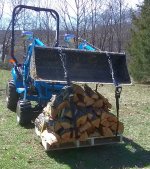PILOON
Super Star Member
I was a lift truck sales rep for a few years so I can offer some information.
Fork capacity is always quoted as weight at a given distance from the pivot point which is the front axle.
Generally the distance is given as @ 24 inches.
Same applies for tractor FEL's (load at center of bucket)
So if a cut bucket is rated @1000 lbs you be sure that with clamp on forks that protrude ahead of bucket by 36 ins or so your new capacity is probably less than 500 lbs (centered on those 36" forks)
(I calculated the exact load would then be 571.42 lbs if the FEL bucket CG is @ 24")
Now another consideration.
Fork lifts use a ridged axle behind the forks while a tractor's front pivots making it a disaster about to happen.
Also a tractor front is really quite weak when it comes to loads.
All this to suggest that most (well built) clamp on forks would be just fine for most light duty tasks.
Fork capacity is always quoted as weight at a given distance from the pivot point which is the front axle.
Generally the distance is given as @ 24 inches.
Same applies for tractor FEL's (load at center of bucket)
So if a cut bucket is rated @1000 lbs you be sure that with clamp on forks that protrude ahead of bucket by 36 ins or so your new capacity is probably less than 500 lbs (centered on those 36" forks)
(I calculated the exact load would then be 571.42 lbs if the FEL bucket CG is @ 24")
Now another consideration.
Fork lifts use a ridged axle behind the forks while a tractor's front pivots making it a disaster about to happen.
Also a tractor front is really quite weak when it comes to loads.
All this to suggest that most (well built) clamp on forks would be just fine for most light duty tasks.


